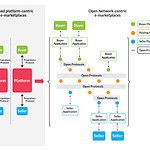Antariksh Matters #1: Fishing out illegal fishing vessels
— Pranav R Satyanath
During the Quad Summit held in Tokyo on May 23, the leaders of Australia, India, Japan and the United States agreed to establish the Indo-Pacific Partnership for Maritime Domain Awareness (IPMDA). This initiative hopes to extend the existing mechanisms for maritime cooperation among the four countries and harness commercially-available data to put together a more accurate picture of the maritime domain.
The Quad countries also plan to use greater cooperation to tackle the issue of illegal fishing by Chinese vessels, as reported by Demetri Sevastopulo in the Financial Times. The report states that the partner countries will use space-based capabilities and existing maritime fusion centres to combat illegal, unreported and unregulated (IUU) fishing carried out by Chinese vessels in the Indian Ocean. The problem of IUU fishing by Chinese vessels is not new, with the IUU Fishing Index 2021 giving China an overall score of 3.86 (a score closer to 1 being the best) – making China the worst performing among 152 countries.
Space-based capabilities to track maritime activities are not new and remain crucial marine safety and sustainability pillars. However, the Quad initiative to enhance maritime awareness through data exchanges is novel, as it brings together state-capacity, commercial capabilities of the partnering countries and publicly-available data to better monitor the maritime domain. There are three main ways to monitor and track maritime activities, which are likely to be used in tandem by the Quad countries. Each of these methods is described below:
Transponder signatures: Any vessel that ventures into the seas is required to have onboard the Automatic Identification System (AIS), a transponder which transmits data about a vessel’s set course, speed and manoeuvres carried out. Further, it also provides details of the vessel’s registry under the International Maritime Organisation (IMO), the vessel’s dimensions and its call sign. Although AIS transponders are not registered, they can be identified by a vessel’s unique 9-digit Maritime Mobile Service Identity (MMSI), which is included in all transmissions.
The IMO requires all international vessels weighing 300 gross tons or more to carry onboard AIS transponders. This requirement initially served the purpose of avoiding accidents and collisions at sea. Today, the AIS data, which anyone with a correctly configured receiver can access, has become an essential pillar of coastal security, monitoring IIUU fishing, tackling anti-piracy, and enforcing international sanctions.
International Registry: The registry of a vessel under the IMO is an authoritative and legitimate identification of a vessel. IHS Markit assigns each registered vessel a unique 7-digit identification number on behalf of the IMO, which can be publicly accessed free of charge. This number remains permanent, even after a vessel changes its flag (the country where the ship is registered). The IMO registry provides details such as the vessel’s ownership, physical features, and registered flag. It remains the most authoritative form of maritime identification.
Physical identification: The final way of identification is by a vessel’s physical features. Since the details of a vessel’s dimensions are already available in the public domain, it can be verified either by coastal surveillance or through satellite imagery. The use of satellite images has become commonplace in the shipping industry. Besides using optical images, new commercially-available technologies such as synthetic aperture radar (SAR) satellites have made it possible for private entities and NGOs to verify several aspects of illegal maritime activities. Furthermore, the use of machine learning to identify vessels at sea is also an upcoming technology used in the maritime domain.
International cooperation has always been an important initiative in combating illegal maritime activities. The United States, for example, has forged several multilateral partnerships to curtail IUU fishing across the world.
Based on the available details about the Quad’s IPMDA initiative, we can speculate that the fusion centres in India, Singapore, Solomon Islands, and Vanuatu will use the methods mentioned above to monitor and track IUU fishing activities. In addition, data gathered by coastal radars, patrol boats, drones and manned patrol aircraft could act as a force multiplier in their effort to mitigate illegal maritime activities.
Matsyanyaaya: A Roadmap for the Quad’s Emerging Technology Working Group
— Arjun Gargeyas
The official statement released by the White House following the first-ever in-person Quad summit in September, outlined the broad areas that the partners were looking at. From 5G and semiconductors to biotechnology, critical areas were identified for the alliance to develop a strategic advantage in. With the launch of the ‘Quad Semiconductor Supply Chain Initiative’, the group signaled its intent to establish itself in the technology domain.
Notwithstanding this pledge, there still exists uncertainties regarding the commitments made on the technology front. There is also the question of how much progress has been made by the member states regarding critical and emerging technologies. With the remnants of the COVID-19 pandemic and new geopolitical events such as the Russia-Ukraine war still affecting several technology supply chains, the Quad has to focus on three main areas to create an immediate impact in the technology domain.
Bubbles of Trade
Extending the concept of the ‘bubbles of trust’ approach that envisages better diplomatic relations between like-minded states, the Quad should set up a mechanism for the free flow of goods, labour, and capital-related to strategic technologies. Taking the example of the semiconductor industry, it is clear that key technology sectors have burgeoned globally and have relied on international cooperation for their growth and sustainability. This ensures that they cannot be restructured in such a short period of time. Robust infrastructure and an efficient value chain have been developed in high-tech sectors due to free trade.
But the current situation has thrown up several key challenges for the Quad to navigate. This includes protectionist measures resulting in high import tariffs and export control regulations preventing access to critical components for building key technology ecosystems. The military applications of these technologies have also raised the fears of weaponisation resulting in lesser collaboration efforts.
The Quad should aim for creating a more liberalised and open market policy that helps the four countries indulge in a greater exchange of goods, labour and capital related to strategic technology sectors. Favourable trade policies encouraging the exchange of technology sector-centric trade must be a priority. The governments of the Quad should focus on developing a comprehensive trade policy suited or catered to building strategic technology ecosystems across all the states.
A Robust IP Protection Regime
With the technological rise of China and the fears of economic espionage, there has been a restriction on the transfer of critical technology between states, thereby hampering the level of growth and innovation in certain fields. This can be addressed by the Quad coming together to build a strong intellectual property (IP) protection framework. It can help in formulating transfer of technology agreements in critical technologies between the states without fears of IP theft.
Securing technology supply chains have become a challenge due to the intrinsic dependencies that have been created in several areas. Technology transfers remain a solid solution to build resiliency in these value chains themselves. However, the qualms of the IP-owning countries have been the fear of these critical technologies leaking out and reaching adversaries.
A starting point for the Quad would be to introduce and ensure the enforcement of strict IP theft rules and regulations to facilitate technology transfer agreements. Prevention of exports, restrictions on domestic operations, and levying fines or penalties for specific firms violating IP theft guidelines will ensure innovation-based competition and create a favorable environment for multilateral collaboration. It must be noted that almost all modern-day technological powers have benefited from the transfer of technology from more advanced states. Hence, it remains in the interest of the Quad to share critical technologies between its alliance members.
Joint Standards Development
The race for technological superiority has moved from the domination of market share to the establishment of governance mechanisms for certain critical technologies. This is where technology or technical standards come into play. Setting standards in crucial technologies have allowed states and companies to reap economic and geopolitical benefits. The Quad has the collective technical expertise to formulate and set technical standards in various emerging technologies.
In recent times, there has been a steady increase in governments’ participation in the process of standards-setting. States are now openly advocating for certain technical standards to be adopted as the global ones which would eventually benefit the state and its domestic private sector. The Quad, as a group, must prioritise pre standardisation research as well as advocate and push for jointly developed technical standards at international standard-setting bodies.
An increase in Chinese influence in these global standard-setting bodies has set alarm bells ringing in the West. The Quad can take over the mantle and establish committees to spearhead standard development activities in technologies like advanced communications, quantum technology, and artificial intelligence. This would put the alliance in the driver’s seat to set and formulate standards that will end up shaping the way future technologies might work.
Antariksh Matters #2: Can you ban space weapons?
— Aditya Ramanathan
Does it make sense for India to pursue arms control in space? The recently concluded session of the Open Ended Working Group (OEWG) meeting in Geneva has infused urgency into this question. The OEWG focused on how space threats could be reduced through norms, principles, and guidelines My colleague Pranav R. Satyanath covered the OEWG in the previous edition of this newsletter.
For our purposes, the OEWG meeting was notable for both the absence of any substantial efforts to ban space weaponry and for the lack of active Indian participation. This Indian reticence will keep it from shaping the future of space security. But to actively intervene in future discussions, Indians will need to agree on a few basics. As Pranav pointed out, states are debating about:
“whether to regulate space capabilities or to regulate space activities; and second, whether to negotiate legally-binding treaties or whether to agree on non legally binding transparency and confidence-building measures.”
This week, I’ll stick to considering the first of these themes: space capabilities. There’s been widespread scepticism about the prospects for arms control in space. One reason for this, as we previously argued, is that space warfare is essentially primitive in its current state – at least when you compared to the highly evolved systems of warfare on Earth that incorporate speciated weapons and platforms fulfilling niche roles on battlefields.
As two scholars with the United Nations Institute of Disarmament Research (UNIDIR) pointed out, potential space weapons are often ‘dual-capable’ systems such as repair satellites that can be used for more hostile purposes. In addition to these dual-capable systems, there exist multi-use capabilities such as direct ascent ASAT missiles, which are largely derived from existing ballistic missile defence (BMD) systems.
If potentially offensive space capabilities are either dual-capable or multi-use, can they really be curbed? To consider this issue, it’s best to look at key factors that usually help decide success in arms control. Paul Scharre suggests three factors that influence the feasibility of a workable deal: “the perceived horribleness of the weapon; its perceived military utility; and the number of actors who need to cooperate for a ban to work.”
We can add two more criteria to this list. One, whether the capability is dual-capable or multi-use. Two, whether verification of compliance with an agreement is feasible.
How do these criteria fare against the implements of space warfare? Since space warfare can be waged on both Earth and in space we must consider each category of weapons. On Earth, space warfare is waged with well-established arms and modes of fighting. The combat aircraft, long-range missiles, or elite infantry forces used to attack Earth-based space assets will not be subject to bans for obvious reasons.
This leaves us with those capabilities that directly target space-based assets. Specifically, these are:
Electronic warfare and cyber attack capabilities
Kinetic ASAT missiles (whether direct ascent or co-orbital)
RPO satellites (such as the aforementioned repair satellites or debris- clearing craft)
Directed energy weapons (such as lasers and high-powered microwaves)
Any future space-to-Earth kinetic weapons such as the once-proposed ‘Rods from God’
The proscribing of offensive space capabilities would work best when:
the perceived horribleness is high
the perceived military utility is low
the number of actors that need to agree is low
the capability in question in not dual-capable or multi-use
verification is feasible
The table below maps how five types of offensive space capabilities fare against these conditions:
Naturally, there is much that is subjective about arms control. In particular, ‘horribleness’ is a slippery concept. For instance, anti-personnel laser weapons that can blind people are proscribed while lasers that target weapons platforms are allowed along with all manner of other conventional and nuclear weaponry that shred or incinerate human beings. As a rule of thumb, weapons that specifically target humans are subject to much greater scrutiny than those that target things – even if attacks on those things leads directly to human suffering. Therefore, electronic warfare and cyber attacks, RPO satellites, and lasers that attack orbital craft are unlikely to elicit the visceral opposition as blinding lasers. The one exception to this rule is the kinetic destruction of satellites. While kinetic collisions in space may not directly kill anyone (though the resultant debris could notionally endanger spacefaring humans), they create serious practical problems and impose high reputational costs, which could, in turn, have serious diplomatic consequences during a conflict.
Candidates for Arms Control
The table makes clear that only one type of system meets all the ideal conditions for arms control: orbital space weapons meant to attack Earth-based targets, such as the so-called ‘Rods from God’ fanciful proposals for orbital craft that will unleash 20-foot-long tungsten rods that act like artificial meteorites, striking hardened targets such as bunkers or ICBM silos.
Despite their evident horribleness, such weapons would have low military utility simply by virtue of being highly vulnerable. To be able to get weapons on target quickly, the orbiting platforms would have to be in low earth orbit, making them easy targets for Earth-based countermeasures such as ASAT missiles. Any user would also need to maintain a sizeable a constellation of these platforms to ensure adequate coverage.
Besides this, no state has invested serious resources into developing ‘Rods from God’, meaning the number of actors is presently zero. Furthermore, any such platform is not dual-capable/ multi-use and their existence can be easily verified, since these large orbital platforms will resemble nothing else circling the Earth.
The other candidate for some manner of arms control is Earth and space-based kinetic ASAT weapons. On the one hand, these weapons possess some clear utility: destroying a satellite puts it out of action permanently and signals serious intent to an adversary. However, a closer examination reveals these weapons score low on military utility and high on horribleness.
Consider utility: the violence of kinetic collisions narrows down its potential use to the sole circumstance of high intensity conventional conflict. If used first by a spacefaring state, it opens itself up to retaliation in kind. Furthermore, to substantially degrade an adversary’s use of space, several satellites will need to be targeted. While non-kinetic capabilities theoretically offer the ability to disrupt multiple satellites for specific periods of time or over specific ground tracks, attempting something similar with kinetic collision could create enough debris to risk India’s own celestial lines of communication.
With high horribleness, low military utility and a relatively small number of actors (only five states including India have proven ASAT capabilities), kinetic kill ASATs seem like good candidates for a ban. However, the multi-use nature of direct-ascent ASAT missiles and the makes any effective ban impractical. What is possible is a ban on destructive ASAT tests. Back in March, we had advocated India unambiguously back such a ban. The following month, US Vice-President Kamala Harris committed the US to a self-imposed ban on such tests and establishing such a moratorium “as a new international norm for responsible behavior in space.”
Having already conducted a successful destructive test in 2019, India is in a good position to support an international moratorium on destructive tests with direct-ascent ASAT missiles.
Working out a Negotiating Position
India’s stance on space security is likely to evolve in the coming years. While traditional arms control is unlikely to serve as a foundation for its strategy, India may do well to propose outright bans on space-to-Earth kinetic weapons, and back a global ban on destructive DA-ASAT tests.
In the coming weeks and months, Pranav and I will examine the effects of the OEWG on space threats, consider ways in which India can best secure its interests.
[Book] The Shock of the Old: Technology and Global History Since 1900 by David Edgerton.
[Article] “Operational Monitoring of Illegal Fishing in Ghana through Exploitation of Satellite Earth Observation and AIS Data by Andrey A. Kurekin et. al.
[Blog] Artifice and Intelligence by the Center on Privacy & Technology










